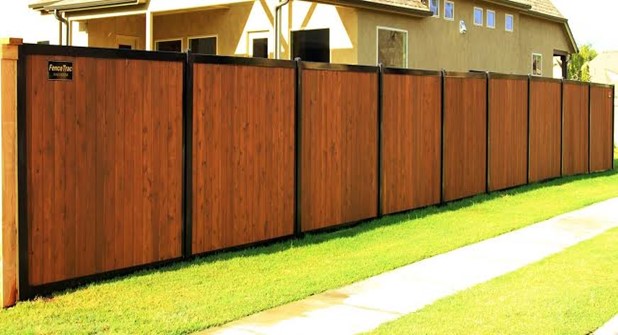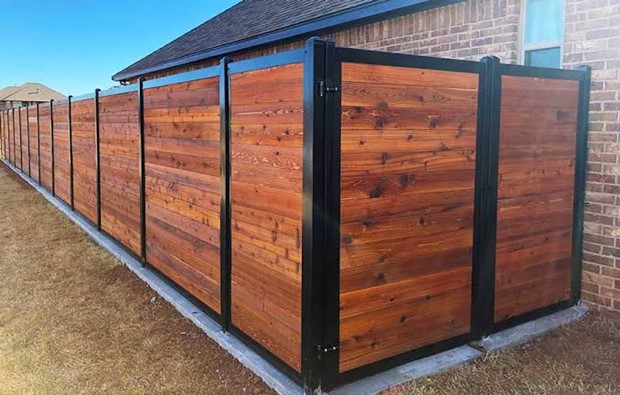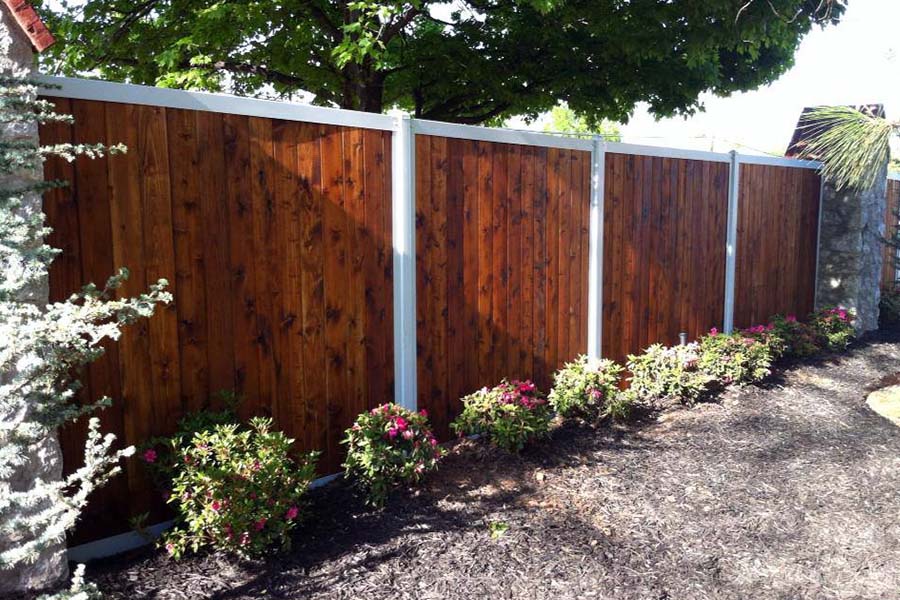If you are considering building your horizontal wood fence with metal posts, it is a great decision, and you are at the right place to know everything about it.
You need not check here and there for the complete information as this article will clear all your doubts and let you know the ins and outs of this whole process.
As you are investing in the wooden fence, it will last for decades and not for years, as wood may get damaged more easily than other solid materials.
However, if you are using metal to hold your wooden fence, here are some things you need to compromise on, as it will not look very good to see your wooden fence with metal posts.
Yet, galvanized metal posts used for your wooden fence would be a good option as they will support your wooden fence, and you can build a chain-link fence.
There is a problem with this, too. This will not look so great when you try to build a wooden fence for any private purpose.
Why Do You Need Metal Posts with Your Wooden Fence?

So, here the question arises: why do you need to use metal posts for building your wooden fence, and why not without them?
Then you will get the complete information about it here in this article. It is more important to use metal posts with your wooden fence than to build without them, as they will increase the life span of your fence.
The normal wooden fences will get damaged and rotten within 7-10 years maximum.
But if you use the wooden posts, it will increase the time, and they will be alive for more than 15-20 years.
When you build a wooden fence, as soon as you put the wooden posts in the ground, they capture the moisture, which may result in a rotten fence after some time.
A few years back from now, in around 2003, a special type of chemical was used to protect the wooden fence from damage and to prolong its life.
The chemical was Chromated Copper Arsenate, a pesticide and preservative to prevent the wood from exposure to moisture in the ground where they are put.
However, after a few years, the use of this chemical got banned by the EPA as it became a potential source of arsenic impurities and exposure may cause many diseases and harmful effects.
After the ban on this chemical, the period of the formal wooden fence started decreasing.
Most of the wooden fences met their early demise as they were rotten at the base and could not stand for a long time in the high winds.
Factors to Consider: Horizontal Wood Fence with Metal Posts

1. Life Span of the Wooden Fence
Metal posts cannot be rotten as easily as wooden blocks, as they have more survival power.
Using metal posts with your wooden fence will give extra strength and life to it.
It has been observed that the life of a wood fence with metal posts is almost double the years of a traditional wooden fence, and sometimes it may be 3 times and 4 times as well as per the records.
So, it has been seen that using metal posts with your wooden fence can increase life to multiple years.
While selecting the metal posts for your wooden fence, you may have a lot of options however if you choose plain galvanised steel posts, painted steel posts, aluminium plated posts etc.
These would be the best for you, cost-effective in the long term, and a wise investment.
This way, not only the wooden fence will be protected, but it will look very beautiful and attractive.
So, it will protect your wooden fence from corrosion and give it a classy look with the strength of galvanized steel.
2. More Privacy
When planning to build a wooden fence with maximum privacy, you must be very selective with the color you choose.
Privacy can be maintained if it is completely covered, and no one will be able to see what is going on on the other side of the fence.
This style of wooden fence picket will create a strong fence for you and provide zero visibility from either side so that you can enjoy your privacy without any second thoughts.
Pickets can be installed vertically, and they can be arranged as per your preference. You can also create a horizontal wooden fence with metal posts using the FenceTrac rail system.
So, you can use horizontal wood privacy fences. You must cut the pickets according to the length requirement and slide them into the rail system.
Each fence panel can be created by four bolts holding the horizontal and vertical rails together.
The vertical rails act as metal post adapters, securing each fence panel to the metal posts. So, it is best to use this technique to build your wooden fence with ensured privacy.
3. Types of Wooden Fences
There are a lot of ideas when you think about building wooden fences, and you can choose the one you like.
So, you are not limited to the options and the same old-looking wooden privacy fence.
Anything will not be accepted if it is not according to you, at least when you can choose the options for it, and you will be the one to decide how it should look.
So, better to choose your design and check all the ins and out for that wooden fence you are planning to be built up and amaze the people around you.
Also, make sure it will not hamper your privacy at any cost and look beautiful at the same time.
You can also use different materials to enhance the look of your wooden fence, such as vinyl planks, polyvinyl chloride, welded wires, and metal panels.
You are free to choose your style and design for your wooden fence, which will be built up for you.
Also, choose the material you want to be used to get it to stand for long and look decent. You can make residential as well as commercial fences as per the requirement.
You can also choose the color of the fence, which may be Red, Black, White, Tan, and Green.
The Standard sizes of the Fence are as follows:
- 4ft H × 6 ft W fence panel
- 4ft H × 8 ft W fence panel
- 6 ft H × 6 ft W fence panel
- 6 ft H × 8 ft W fence panel
- 8 ft H × 8 ft W fence panel
So, once the fence is ready, you can connect one gate to it according to the latest style and design that will suit your fence.
You can check online and at the hardware stores for the latest designer gates like railing gates and swinging gates.
Pros and Cons: Using Horizontal Metal Posts in Wooden Fences

When planning to build a wooden fence, one crucial decision is the choice of posts.
Metal posts are a popular option, offering several benefits, but they also come with certain drawbacks.
This article aims to provide a balanced perspective to help you make an informed decision.
1. Advantages of Metal Posts
- Durability: Metal posts, especially those that are galvanized, are highly resistant to weather, rot, and insect damage, significantly extending the life of your fence.
- Maintenance: Unlike wooden posts, metal posts require minimal maintenance. They do not need regular sealing or staining to maintain their condition.
- Strength: Metal posts can provide greater structural support to your fence, making it more resistant to strong winds and physical pressure.
- Aesthetics: With advancements in design, metal posts can be aesthetically pleasing. Systems like FenceTrac offer a sleek, modern look consistent on both sides of the fence.
2. Drawbacks of Metal Posts
- Cost: Metal posts can be more expensive upfront than traditional wood posts. This initial investment may be a consideration for those on a tight budget.
- Installation Complexity: Installing metal posts can be more complex and may require special tools or professional assistance, adding to the overall cost and effort.
- Aesthetic Limitations: While metal posts have come a long way in design, some people may prefer the natural look of all-wood fences. Metal may not blend as seamlessly into certain landscapes or architectural styles.
- Corrosion: Although galvanization helps prevent rust, metal posts can still be susceptible to corrosion, especially in coastal or harsh weather environments.
3. Alternatives to Consider
- Treated Wood Posts: These are a traditional choice and can last many years when properly treated and maintained. They offer a natural aesthetic that many homeowners prefer.
- Composite Posts: Made from a mixture of wood and plastic, these posts balance the natural look of wood and the durability of synthetic materials.
- Recycled Plastic Posts: For an eco-friendly option, recycled plastic posts are durable, maintenance-free, and resistant to rot and insect damage.
- Concrete Posts: They provide immense strength and durability but have increased installation difficulty and a distinct aesthetic that might not suit all tastes.
Wooden Fence Metal Posts: Types, Installation, and Maintenance

When considering the construction of a wooden fence, incorporating metal posts is a practical and long-lasting option. This article delves into the specifics, offering insight into the various types of metal posts, their installation process, and maintenance tips to ensure durability and aesthetic appeal.
1. Types of Metal Posts for Wooden Fences
- Galvanized Steel Posts: Highly popular for their resistance to rust and corrosion. These posts are coated with a layer of zinc, offering enhanced durability.
- Powder-Coated Steel Posts: Known for their aesthetic versatility, these come in various colors. The powder coating provides an extra layer of protection against the elements.
- Aluminum Posts: A lightweight yet sturdy option, aluminum posts resist rust and corrosion naturally and work well in coastal areas with salty air.
- Stainless Steel Posts: Though more expensive, they offer superior strength and rust resistance, ideal for harsh weather conditions.
2. Installation Process of Metal Posts
- Planning and Measurement: Begin by marking the boundary line of the fence. Measure and place markers for where each post will be installed, typically 6 to 8 feet apart.
- Digging Holes: Using a post-hole or auger, dig holes approximately 2 feet deep and wide enough to accommodate the post.
- Setting the Posts: Place the metal post in the hole and ensure it’s level. Pour concrete into the hole around the post and let it set according to the concrete manufacturer’s instructions.
- Attaching Fence Rails and Panels: Once the posts are secured, attach horizontal rails between them. These rails will support the wooden fence panels or pickets.
3. Maintenance Requirements
- Regular Inspection: Check for any signs of damage, loose bolts, or wear and tear, especially after severe weather conditions.
- Cleaning: Wash metal posts with mild soap and water to remove dirt and grime. Avoid using harsh chemicals that might damage the zinc coating for galvanized posts.
- Rust Prevention: If scratches or exposed areas are noticed, apply a rust-inhibiting primer and touch-up paint to prevent rust.
- Lubrication: Regularly lubricate the hinges and locks for posts with moving parts like gates to ensure smooth operation.
- Immediate Repairs: Address any damages or issues immediately to prevent further deterioration.
Considering these details, homeowners and builders can make informed decisions when integrating metal posts into wooden fences.
This approach enhances the fence’s longevity and ensures its functionality and aesthetic appeal. For personalized advice on integrating metal posts into your wooden fence project, consult experienced fence builders.
Final Thoughts
In summary, when it comes to building a wooden fence, the choice of posts—metal, wood, composite, or another material.
It is a critical decision that impacts the fence’s durability, aesthetics, maintenance requirements, and cost.
Metal posts offer undeniable strength and longevity, making them a robust choice for areas with harsh weather conditions or those seeking minimal maintenance.
However, they also come with higher initial costs and a specific aesthetic that may not blend with all landscapes.
On the other hand, alternatives like treated wood or composite posts provide different benefits, such as a more natural look or eco-friendliness, which might align better with personal preferences and environmental considerations.
The key is to weigh these factors against your individual needs, budget, and the desired appearance of your fence.
By doing so, you can choose the most suitable post material for your fence, ensuring it meets your expectations in terms of both functionality and style.

